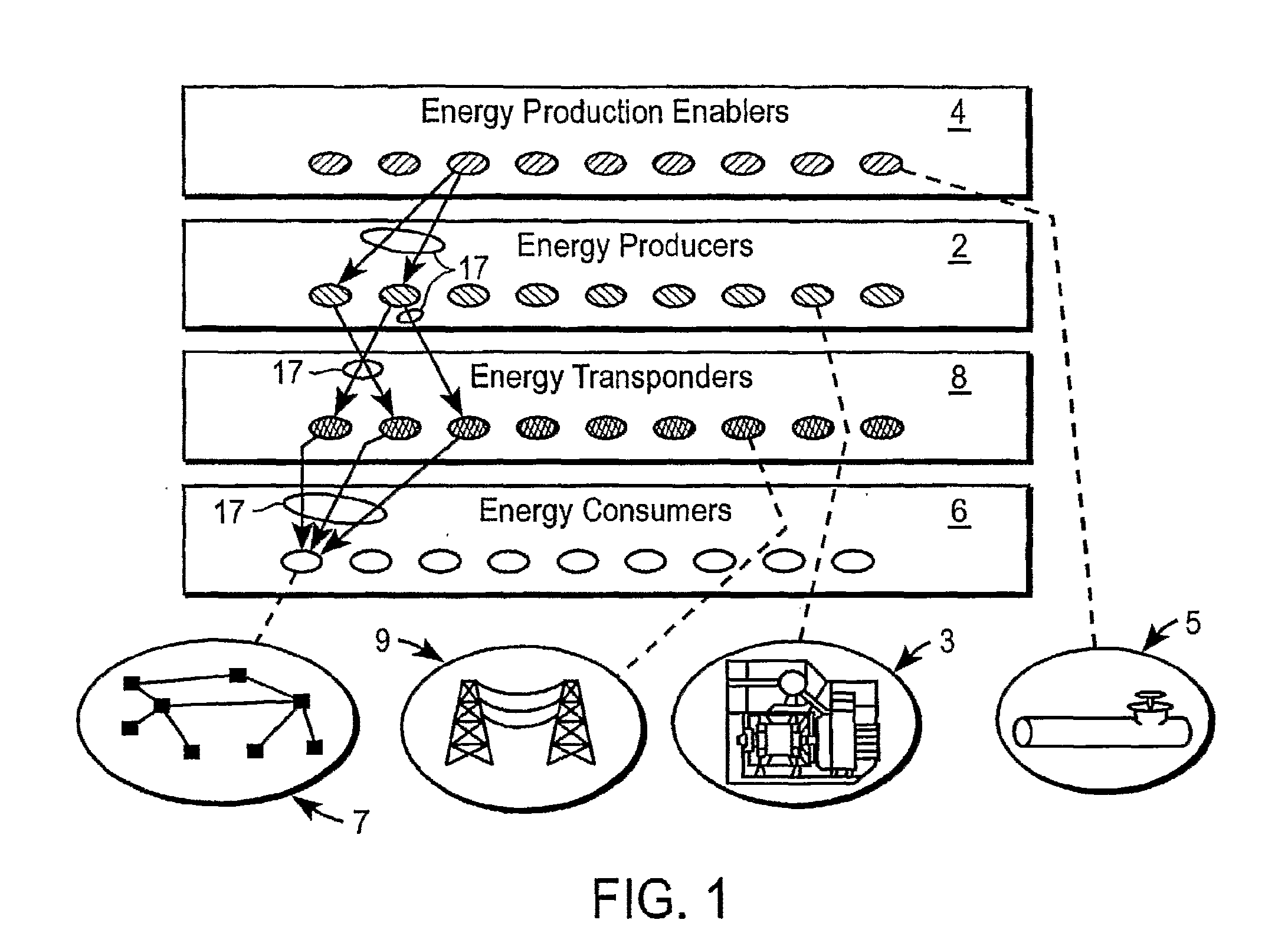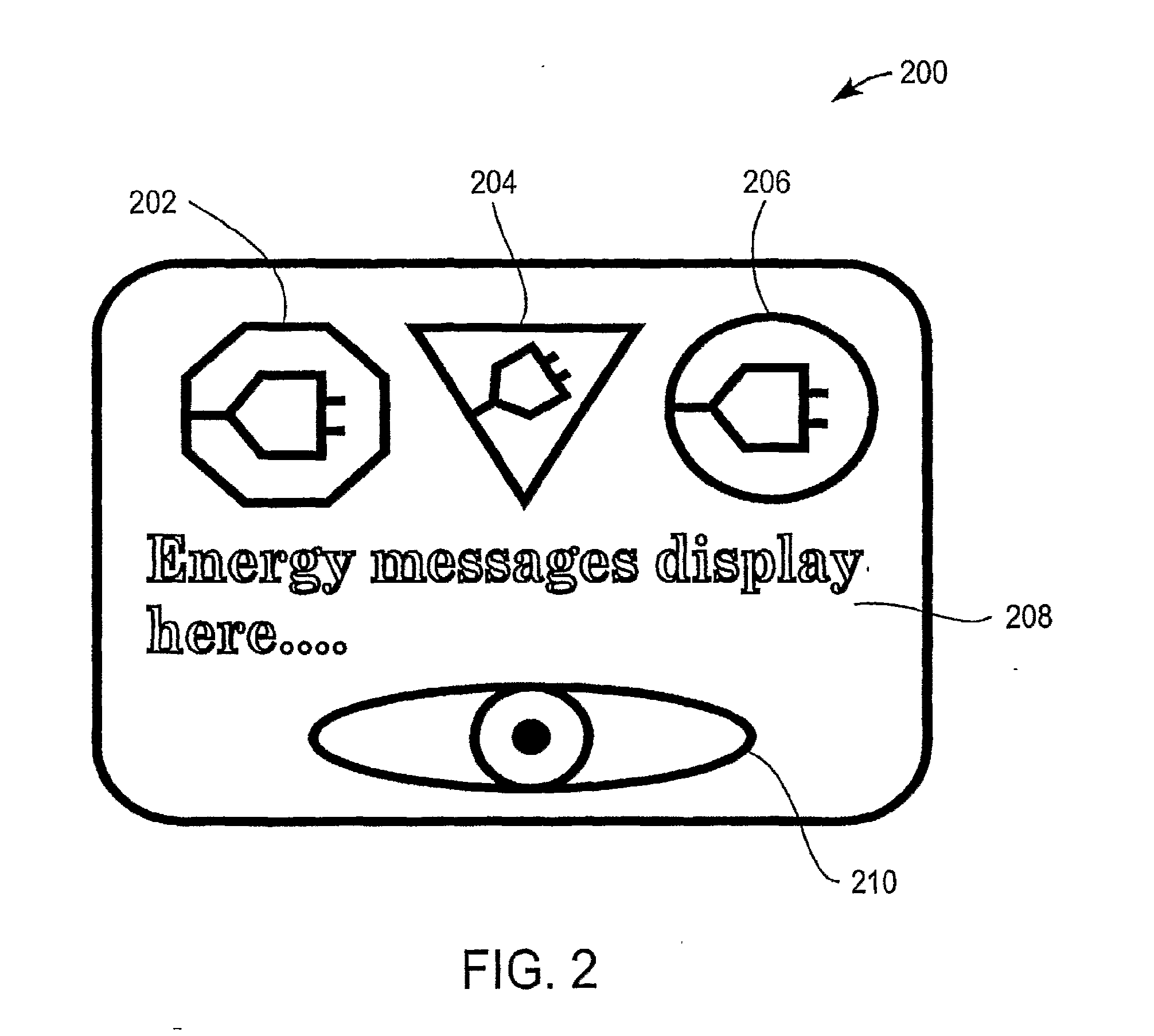Energy generation, distribution, and / or consumption systems (“energy-related systems”) are complex.
The complexity of such systems is further increased when one considers that many, if not all, energy producers themselves are complex systems that convert non-electrical
energy resources such as
fossil fuel, nuclear,
wind power, or
solar energy resources into, for example, electrical energy, and that require additional resources such as
chilled water for their operation.
That is, the complexity of energy-related systems is further increased if one considers the scope of such systems to include the relationships between energy producers and upstream energy production enablers that make it possible for those energy producers to operate.
A problem confronting this industry today is the great variance in
total energy demand on a network between peak and off-peak times during the day.
However,
energy consumption is far from the only operational aspect of energy-related systems that can necessitate rapid, reliable and accurate changes to
system operation.
As in the case of energy consumers, environmental regulations and market forces pertaining to the price of electrical energy can
impact the operation of energy producers as well.
Yet the operation of the energy production enablers also is susceptible to fluctuation for a variety of reasons including, again, environmental regulations and market forces.
For example, storms and other weather-related conditions can occasionally disable or disrupt the operation of power lines that are transmitting electrical energy.
Yet conventional energy-related systems are often limited in this regard, particularly in terms of controlling and coordinating the interdependent operations of different energy consumers, energy producers, energy production enablers and energy transporters.
In particular, central control systems for allowing
system-wide control of energy-related systems have typically been impractical to implement for several reasons, particularly the difficulty and expense associated with designing control programs for such complicated systems.
While this type of
direct control of
power consumption by the utility achieves usage cutbacks during peak periods that prevent the power network from becoming overloaded, in many cases, the great inconvenience to the user who may find his power disconnected for an inordinately long time may well outweigh the benefits of the
load shedding.
First, fixed-period
duty cycling tends to destroy “natural diversity.” Natural diversity can be illustrated in terms of many machines supplied by a common power network. A large group of
air conditioning or heating machines that continually cycle ON and OFF to maintain comfort conditions in corresponding spaces have a natural tendency to operate such that the
cycling pattern of each
machine is in random phase with the
cycling pattern of all other such machines in the power network. In this fashion, there is but a random likelihood that all of the
air conditioning compressors or heating machines will be operating at the same instant. The tendency for this random operation is then called natural diversity. Any
load shedding strategy that tends to synchronize the running periods of all the compressors or heaters in the utility service network reduces natural diversity. Synchronization causes significant spikes in
power demand during the ON cycle of these devices and negates much of the benefits of the
load shedding. If the devices to be interrupted are electric
air conditioning and
cooling units, for example, the chances are that all such units whose power supply has been interrupted will be calling for power at the end of the OFF cycle such that a spike in
power demand will occur upon switching of the interrupted units at the end of each cycle.
Also, this method of load shedding may be defeated or overcome by the customer by the installation of an oversized air conditioning or heating unit such that it may maintain the temperature of the environment utilizing only that portion of time allotted to it.
The general problems associated with all such load shedding methods and devices is that, while they may accomplish a certain amount of load shedding which benefits the
electric utility, they largely ignore a very important factor, the
impact of one or more
modes of interrupted services on the customer or user.
Abrupt or large changes in the
environmental temperature of a conditional space are very undesirable from the standpoint of the customer.
This step change can result in a significant energy savings over a long period, but yields only a relatively small power reduction at the
peak load time.
Moreover, such a method does not allow users to make informed decisions regarding temperature settings or energy usage based on current energy prices.
While functional, the Hammer system has the drawback that it still requires nonvoluntary cessation of
power usage.
Furthermore, the Hammer system is only useful for electrical space conditioners and not other power consuming household appliances such as dishwashers, hot water heaters, vacuum cleaners,
sprinkler system,
water irrigation pump, and the like.
Thus, the Hammer system will only provide limited relief to an overtaxed utility grid during periods of peak usage or during
emergency situations in which
power demand outstrips power supply.
However, Faulkner, like Hedges is unsatisfactory at least in part because the utility manages the demand of the customer.
Ehlers does not disclose any datacast or other ubiquitous or comprehensive transmission means by which tariff data is delivered directly to an appliance controller.
A drawback with Maturana is that it is expensive to implement and tends to require mandatory curtailment of energy use by the energy
consumer.
Furthermore, such systems are also unsatisfactory due to the liability associated with such forced appliance control.
Few customers want their energy provider forcing them to live a specific way or changing their appliance operation without their knowledge.
However, if faced with the choice of the power going out, or rolling blackouts, such customers may reduce their consumption if the system is effective.
However, such systems suffer from a number of shortcomings.
A first drawback with LAN-based systems for load shedding is that their implementation requires the addition of significant on-premise infrastructure.
This is because residential and commercial buildings are typically not equipped with the type of
local area network wiring suitable for such systems.
The cost of installing such systems using dedicated wiring is prohibitive.
However, access point base stations and
transceiver clients needed to support such
wireless networks tend to be costly and are susceptible to
noise and co-channel interference due to their operation in unlicensed frequency bands.
However, such communication systems are subject to inherent reliability problems due to
electromagnetic interference (e.g.
TRIAC based light dimmers),
signal isolation across power line phases, and adjacent and co-channel interference from neighbors who use power line control systems that share the same
low voltage transformer.
Higher performance systems mitigate some of these problems but with increased cost.
For instance, a failure on the part of the
receiver or
server can render the entire system inoperable.
In some instances, depending on the type of failure, there is a danger that utility customers and the appliances used by such customers could be left in a load shed state until the failure is rectified.
In fact, if the affected utility customers are not able to diagnose the problem as a failure in a LAN-based
transmitter, the problem may persist for even longer periods of time and lead to considerable inconvenience and hardship.
A third shortcoming with LAN-based approaches is that many appliances are not amenable to load shedding schemes that simply disconnect and reconnect
AC power at arbitrary times. Refrigerators, for example must maintain an average temperature over time in order to preserve products requiring
cold storage.
However, this system has drawbacks.
It does not facilitate customer intervention to accommodate lifestyle needs, it is susceptible to failure due to its centralized architecture, it employs a costly wired
local area network layer, and it only uses external disconnect switches that are not suitable for many load sheddable appliances.
While functional, the system has the
disadvantage of being expensive to implement because it requires a networked computer to control and monitor a number of sensors in a
residence.
However, Gilbert has the drawback that it uses a centralized EPM
server.
As such, the system is at risk to complete failure at times when the EPM
server is not functional.
Furthermore, Gilbert has the drawback of employing a costly two-way local communication network.
In summary, various known systems for
residential energy control and load shedding each have one or more of the following disadvantages: being overly complex, expensive, unreliable, inflexible, or ineffective.
Large numbers of active small generators can't be actively managed using today's technologies.
However, in conventional systems, people paying such a premium for such
wind power would have no idea when wind power is available.
Further, because wind power is not available all the times, such consumers would not know if their power was coming from wind turbines or somewhere else.
This means that customers can't “vote with their power habits” as to what kind of energy they want to use.
Currently consumers have limited price incentive to manage their use of
electricity as there is no
price differential or way to measure consumption at different time periods.
The problem with such smart meters is that they do not provide a convenient mechanism by which to inform customers of current power rates.
 Login to View More
Login to View More  Login to View More
Login to View More 


